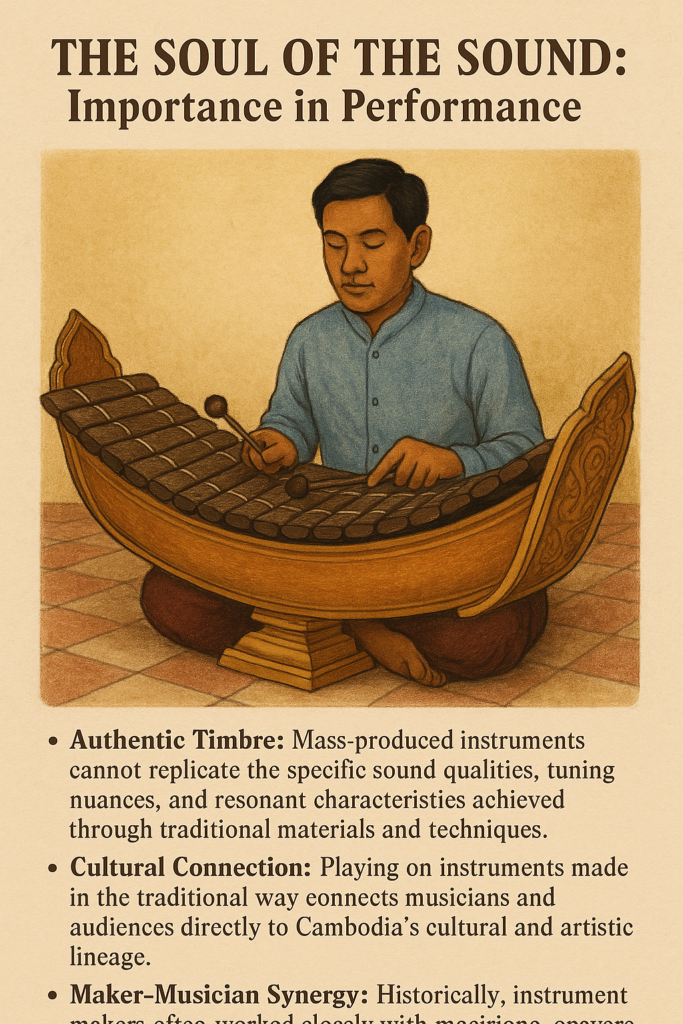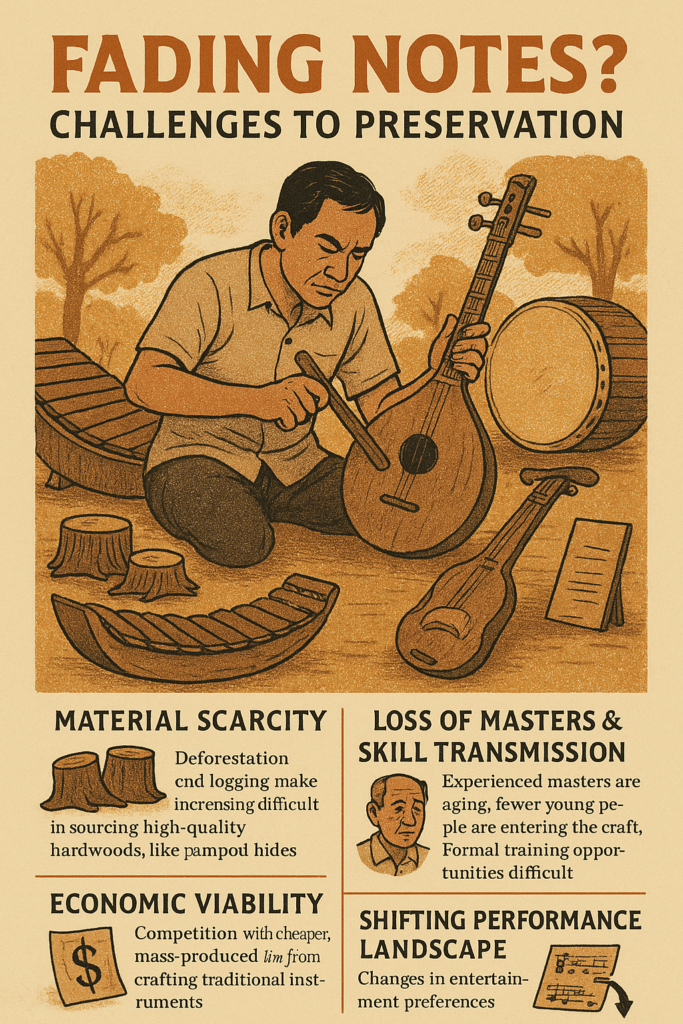The captivating sounds of traditional Khmer music, which accompany sacred rituals, court dances, shadow puppet theatre, and village celebrations, are brought to life by unique and beautiful musical instruments. Behind every resonant xylophone bar, taut drum skin, and vibrating lute string lies the skill of a dedicated craftsperson (neak thveu kroeung dontrey). The art of making traditional Khmer musical instruments is a specialized heritage, demanding deep knowledge of natural materials, acoustics, intricate woodworking, and the cultural context of the music itself, passed down through generations.
Striking the Keys: Crafting the Roneat (Xylophone)

The shimmering, percussive melodies of the Roneat Ek (lead xylophone, higher pitch) and the resonant tones of the Roneat Thung (supporting xylophone, lower pitch) are iconic sounds of the classical Pinpeat ensemble. Crafting these involves:
- Materials: Keys are traditionally made from highly resonant woods like Neang Nuon, Kranhung (rosewood), or sometimes seasoned bamboo. The trough-like resonator body (
rong), often gracefully curved like a boat, is typically carved from hardwood. - Process: The maker meticulously cuts and shapes the wood or bamboo into rectangular bars of varying lengths. The most critical stage is tuning: carefully shaving slivers from the underside of each key to achieve the precise pitch required for the Khmer musical scale. A traditional tuning paste called
pramuk(made from beeswax and lead shavings) is often applied beneath the keys, allowing for fine adjustments to pitch and resonance. The ornate resonator box is also carefully constructed to amplify the sound correctly.
The Heartbeat: Crafting Skor (Drums)

Drums provide the rhythmic foundation and dynamic pulse for much Khmer music. Key examples include:
- Skor Thom: A pair of large, barrel-shaped drums played with sticks, essential for the powerful sound of the Pinpeat ensemble, often used in ceremonies and royal music.
- Samphor: A double-headed barrel drum, tapered towards the ends, played with the hands. It serves as the lead drum in the Pinpeat ensemble, setting the tempo and signaling changes.
- Process: The bodies (
sbaek skor) are traditionally carved and hollowed from sections of hardwood logs. Treated hides, often from cow or buffalo, are stretched taut over the openings to create the drumheads. These are secured and tensioned using leather straps, rattan cords, or sometimes pegs. For drums like the Samphor, a tuning paste (bay kdang, often a mixture of rice and ash) is applied to the center of one or both heads to lower the pitch and control overtones, creating its characteristic resonant yet focused sound.
Whispers on the Wind: Crafting the Khloy (Flute)

The plaintive, airy sound of the Khloy, Cambodia’s traditional duct flute, adds a lyrical voice to various ensembles.
- Materials: The best
Khloyare made from specific types of bamboo (rusei) chosen for their straightness, wall thickness, and appropriate bore diameter. Some are made from hardwood. - Process: The artisan selects a suitable bamboo section, cuts it to length, and meticulously drills the finger holes. The placement of these holes is critical for achieving the correct pitches of the Khmer scale. A key part is crafting the fipple – the mechanism near the blowing end that directs the air across a sharp edge to produce sound. Some
Khloyincorporate a membrane (kantong sneng) over a hole near the fipple, traditionally made from bamboo lining or rice paper, which adds a characteristic buzzing quality to the tone. Tuning requires careful adjustment of hole sizes and the fipple, relying heavily on the maker’s ear. Different sizes exist, like the smaller, higher-pitchedKhloy Ekand the larger, lower-pitchedKhloy Thom.
Voice of the Storyteller: Crafting the Chapei Dong Veng

The Chapei Dong Veng is arguably Cambodia’s most iconic stringed instrument – a long-necked lute recognized by UNESCO as Intangible Cultural Heritage of Humanity (listed 2016). It’s intrinsically linked to a unique genre of witty, improvised sung poetry and storytelling.
- Materials: The body is carved from hardwood (like Beng, Teak, or Kranhung). The defining feature is its very long neck, also made of hardwood, often decorated with intricate carvings or inlay. The soundboard might be wood or sometimes stretched animal skin. Frets are traditionally made of bamboo or wood, and tuning pegs are wood. Strings, once silk, are now usually nylon or metal guitar strings.
- Process: Crafting a
Chapeirequires exceptional woodworking skill. The resonating body must be carefully shaped, the long neck precisely attached and fretted according to the traditional tuning system (which differs from Western scales), and the tuning pegs fitted securely. The balance, acoustics, and playability are paramount. The skill lies not just in the physical construction but in understanding how the instrument needs to sound and feel for the demandingChapeiperformance style.
The Soul of the Sound: Importance in Performance

Using authentic, handcrafted instruments is vital for traditional Khmer music:
- Authentic Timbre: Mass-produced instruments cannot replicate the specific sound qualities, tuning nuances, and resonant characteristics achieved through traditional materials and techniques. The unique voice of each instrument type is essential for the integrity of ensembles like the Pinpeat or Mahori.
- Cultural Connection: Playing on instruments made in the traditional way connects musicians and audiences directly to Cambodia’s cultural and artistic lineage.
- Maker-Musician Synergy: Historically, instrument makers often worked closely with musicians, or were musicians themselves, ensuring the instruments were perfectly suited for the demands of the music. This deep understanding contributes to the quality of the instruments.
Fading Notes? Challenges to Preservation

Despite its cultural importance, the craft of traditional instrument making faces significant challenges today:
- Material Scarcity: Deforestation and logging make it increasingly difficult and expensive to source the specific high-quality hardwoods (like Kranhung or Neang Nuon) needed for many instruments. Good quality bamboo and animal hides can also be harder to find.
- Loss of Masters & Skill Transmission: Many experienced masters are aging, and fewer young people are taking up this demanding, time-consuming craft, which often offers low financial returns. Formal training opportunities are limited.
- Economic Viability: Competing with cheaper, mass-produced (though often unsuitable) instruments and earning a sustainable livelihood solely from crafting traditional instruments is difficult.
- Shifting Performance Landscape: While efforts exist to promote traditional music, changes in entertainment preferences can impact the demand for traditional instruments.
Finding the Authentic Sound: Where to Buy Instruments

Acquiring genuine, high-quality handcrafted Khmer musical instruments requires care:
- Directly from Makers: The best approach is to connect with known master craftspeople. This often requires networking within the traditional music and arts community, possibly through contacts in Phnom Penh, Siem Reap, or potentially skilled individuals in provinces with strong artistic traditions like Battambang.
- Arts Organizations and Schools: Institutions like the Royal University of Fine Arts (RUFA) in Phnom Penh or NGOs dedicated to cultural preservation like Cambodian Living Arts (CLA) can sometimes facilitate connections with reputable makers or may occasionally sell instruments made by affiliated artisans.
- Specialized Shops (Use Caution): Some shops, particularly in tourist hubs, sell traditional instruments. However, quality varies immensely. It’s crucial to distinguish between functional instruments crafted by skilled artisans and decorative souvenirs. Be prepared to assess the materials, craftsmanship, and sound quality carefully. High-quality instruments are artistic creations and will be priced accordingly.
Preserving Cambodia’s Soundscape

The neak thveu kroeung dontrey are unsung heroes of Cambodian culture, preserving the tangible means through which the nation’s unique musical heritage is expressed. Their skill ensures that the resonant calls of the Roneat, the driving rhythms of the Skor, the lyrical sighs of the Khloy, and the storytelling twang of the Chapei Dong Veng continue to be heard. Supporting these artisans – through fair compensation, facilitating knowledge transfer, and fostering appreciation for traditional music – is essential for keeping Cambodia’s unique soundscape vibrant. Recognizing the artistic spirit prevalent even in provinces like Battambang offers hope that these skills, though challenged, continue to find dedicated hands to carry them forward.



